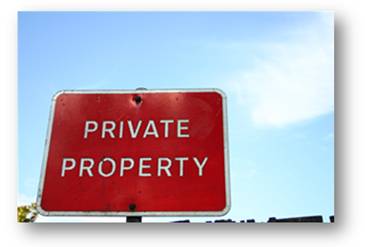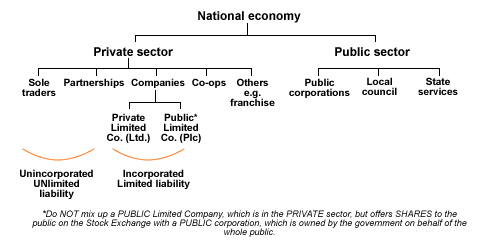Private and public sector
 Most of the businesses or organisations that we have looked at so far have been in the private sector of the economy. These are any organisations owned, controlled and managed by private individuals, usually for the purpose of making profit.
Most of the businesses or organisations that we have looked at so far have been in the private sector of the economy. These are any organisations owned, controlled and managed by private individuals, usually for the purpose of making profit.
The public sector is the government sector of the economy - don't muddle this with the general public - they are the private sector! This is referred to as public ownership. It was considered that the government would act in the interests of the population by providing vital services, even if there was no profit in this provision. Merit goods are goods, such as medical care and education, which might not be provided to all of the population by the private sector as there may be no profit here. Government may allow access to all people even if they cannot afford to pay. This is because the government believes the provision of these goods is in the interests of society.
Public ownership is much less common these days as it is believed that businesses are much more efficient if they are privately owned. In the past few decades (since the start of the 1980s) many businesses around the world have been privatised. This means that they have been changed from public ownership to private ownership. However, the balance between public and private ownership varies considerably from country to country. In recent years, several governments have begun to create partnerships with the private sector, which may run some aspects of public sector services such as hospitals and schools, even though these services have not been privatised. These are called public/private partnerships or enterprises, and are to be found in areas such as education and transport. Here the state organises the delivery of the service, while private companies provide some, or all, of the infrastructure.
SUMMARY of types of organisations in the private and public sectors

Summary of types of organisations
Why not search around government web sites in your country to find data on the proportion of private and public companies?

Privatisation
Privatisation is the selling of nationalised or state-owned industries to private investors, moving the organisation from the public to the private sector.
It is claimed that privatisation:
- Reduces costs - the profit motive, and competitive pressures will drive costs down. Often a state regulator ensures that private firms do not exploit their monopoly position in the market.
- Increases choice
- Increases quality
- Encourages innovation and invention
- Brings market forces into play in a positive manner for the consumer
- Saves the government money - the costs of the nationalised industries would be replaced by income from business taxes
- Widens share ownership in the population
Privatisation also has some possible problems:
- Monopolies will be in private hands e.g. transport
- Loss of equity - the general public loses a valuable resource
- Externalities - the private firm may not be so careful about creating pollution and other external costs, as they are only responsible for paying private costs (in other words the rewards for the four factors of production).
Privatisation in many countries has been accompanied by the introduction of deregulation, but also the appointment of regulators to reduce the opportunity for exploitation. These regulators are expected to act as 'watchdogs' to protect consumers and other stakeholders.

Deregulation
Deregulation is the removal of government rules, controls and restrictions on production and trade.
Some industries have in the past been government monopolies to protect them from competition. Deregulation is the removal of these government controls from an industry. Regulators control or regulate privatised monopoly industries.
